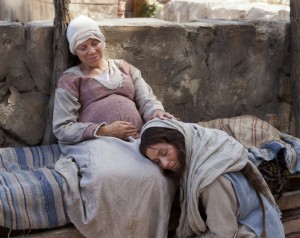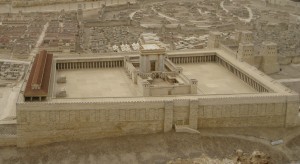by S. Kent Brown
The earliest recorded prophecy that points to Mary and her son arises in Isaiah’s book. As he reports, he is commanded to meet Ahaz, the King of Judah, while the King and his party are inspecting “the conduit of the upper pool” on the north side of Jerusalem because this pool and its channel supply water to the temple and the city (Isaiah 7:3). The year is 734 B.C. and the city is surrounded by two hostile armies, one from Syria and one from the northern kingdom Israel. The King and his associates are at risk while outside the city’s walls. And so are Isaiah and his son when they go to meet them.
After Isaiah assures the King that the siege will soon be lifted, the prophet invites Ahaz to ask for “a sign of the Lord” to prove that the Lord will move events to this end. The King declines in an act of feigned humility that draws Isaiah’s ire (Isaiah 7:12–13). Thereupon, the prophet declares that “the Lord himself shall give you a sign; Behold, a virgin shall conceive, and bear a son, and shall call his name Immanuel.” This prophecy is fulfilled, at least in its distant future meaning, in Jesus’ birth to Mary (Isaiah 7:14; Matthew 1:22–23).
Centuries later, in Nazareth, the angel’s appearance to Mary changes everything for her. Notably, the angel’s mention of Elisabeth’s pregnancy offers a way for Mary to get away from the small town of Nazareth where everyone knows everyone else and where her promised pregnancy will soon become apparent. According to Galilean Jewish custom, pregnancy during the period of betrothal causes a scandal and can invalidate the planned marriage. Going to Elisabeth puts Mary in the arms of the one person who knows both the challenges of silent and open criticism by one’s relatives and acquaintances as well as how to keep her head up in the face of disapproval. Mary must have gone to the home of Zacharias and Elisabeth with the approval of her parents and perhaps in the company of an older family member. Surely, she will have gone in a traveling group for safety, a necessary circumstance that Jesus’ parents enjoy years later when they travel to Jerusalem with their youthful son Jesus in a group of fellow travelers (Luke 2:44). After all, roads are dangerous for the solitary traveler (compare Luke 10:30), and the more so for a young woman.

Mary visits Elisabeth. From the Bible Videos series. Courtesy The Church of Jesus Christ of Latter-day Saints.
It is in her cousin’s home that young Mary’s spiritual character becomes even more visible. For after Elisabeth speaks “with a loud voice” when welcoming her youthful cousin (Luke 1:42), Mary begins to sing. The written inspiration for Mary’s words has long been known, the prayer of Hannah (1 Samuel 2:1–10), an indicator that Mary already knows much of the Old Testament. But Mary’s song, called the Magnificat from the first word in the Latin translation, goes beyond that of Hannah who mainly celebrates God’s exaltation of the low people of the earth, an idea that includes herself and her young son Samuel. In contrast, Mary’s song is chiefly one of redemption, both for her (“[God] that is mighty hath done to me great things”—Luke 1:49) and for others (“his mercy is on them that fear him”—Luke 1:50). The theme of redemption appears even in tiny details. For instance, Mary repeats the words “from henceforth” (Luke 1:48). These become a characteristic expression of Luke that, in most cases, points to Jesus’ redemptive act (Luke 12:52; 22:18, 69; Acts 18:6). Further, in the Septuagint the term “great things” (Luke 1:49), megala in Greek, often refers to God’s actions during the Exodus on behalf of the children of Israel, thus carrying the sense of redemption (LXX Deuteronomy 10:21; 11:7; Judges 2:7).
The trip back to Nazareth must have been emotionally taxing for Mary. After all, we have no indication that she shares the news about the angel with her family before she visits Elisabeth. On the basis of Matthew’s note, “she was found with child” (Matthew 1:18), it appears that only when she becomes visibly pregnant does she confide in Joseph. His reaction? Obviously, he does not believe her story about the angel which she must have told him to explain her condition. His parents’ reaction? We do not know. Nor do we learn the response of Mary’s parents. Joseph’s family, naturally, has every right to demand that the betrothal be undone. This is the direction Joseph goes. Fortunately, as an honorable person, he is “not willing to make her a publick example” (Matthew 1:19). He steers Mary away from severe punishment. Then God reaches out to this good young man through His angel (Matthew 1:20–21). What the next few months are like, we are not informed. We can imagine that Joseph and Mary are happy to leave Nazareth for Bethlehem. By then, their engagement, which effectively marries them, is over and, by custom, she has been escorted to his home as many ancient manuscripts affirm by reading simply “Mary his wife” in Luke 2:5. In a word, they are married.
—Based on The Testimony of Luke by S. Kent Brown, an e-volume in the BYU New Testament Commentary Series.
Part One: An Angel Comes to Galilee
Part Three: Joseph and Mary
Part Four: Bethlehem and Beyond





